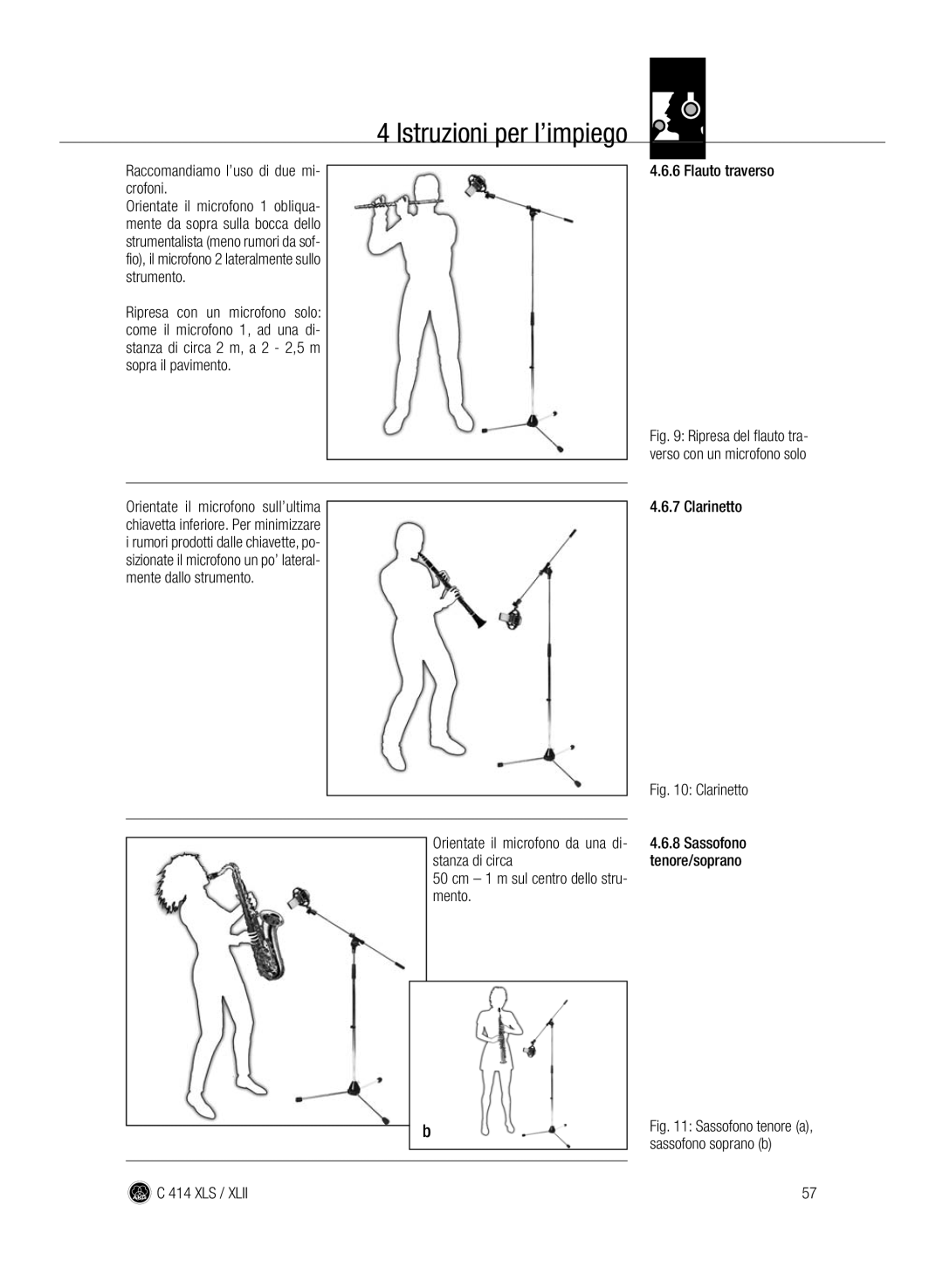414 XLS Xlii
Inhaltsverzeichnis
Sicherheit und Umwelt
Willkommen
Ihr Händler berät Sie gerne
Beschreibung
Verhindern
Lock Mode aktivieren
Die Richtcharakteristik
Deaktiviert Hinweis
Wahlschalter für Tiefenabsenkung
Wahlschalter für Vorabschwächung
Stromversorgung
Anwendungshinweise
XLS / Xlii Aufstellungstipps Solostimme Abb Solosängerin
Aufnahmequelle 414 XLS Xlii
Violine, Viola Abb Violine
Begleitchor/Variante
Cello/Variante Siehe Kontrabass
Kontrabass
Wir empfehlen, zwei Mikrofone zu verwenden
Abb Akustische Gitarre mit einem C
Klarinette Abb Klarinette Tenor Sopransaxophon
Querflöte
Pianino
Sche zu reduzieren Flügel Richten Sie ein C 414 oder zwei
Gitarre
Gitarre/E-Bass Abb E-Gitarre Schlagzeug
Bass
Abb Schlagzeug
Tuch
Mikrofon
Nach dem Trocknen wieder einsatzbereit
Arbeitsweise
Technische Daten
Polardiagramm
Frequenzgang
414 XLS
Table of Contents
Safety and Environment
Safety Environment
Welcome
XLS or C 414 Xlii
Description
Years
Selector once or several times
Lock Mode
Switch phantom power back on
Later
Polar
Preattenuation Pad Selector
Stunning, three-dimensional recordings XLS / Xlii
Bass Cut Selector
From a concert hall ceiling
Powering
Using Your Microphone
Sound source 414 XLS Xlii
Highly recommended Recommended
Lead Vocals
Solo violin
Backing vocals/technique
Large string sections
Viola
Double bass
We recommend using two micro- phones
Cello/technique Refer to Double bass above
Double Bass, Cello
XLS / Xlii Clarinet
Flute
Grand and Upright Pianos
Upright piano
Electric bass
Electric guitar
Overhead miking
Hanging and floor toms
Specifications
Cleaning
Omnidirectional
Frequency Response Polar Diagram 414 XLS
Bienvenue
Sommaire
Alimentation
Caractéristiques techniques
Sécurité et environnement
Bienvenue
Luxueuse mallette de transport
Accessoire optionnels
Tionnés pour lapplication actuelle
Débranchez le microphone puis le rebranchez Mode Lock
De la caractéristique de directivité
Remarque
Sélecteur de pré-atténuation
Sélecteur de pré-atté- nuation
Et sans problèmes XLS / Xlii
Alimentation
Ceptionnelle
Conseils d’utilisation
Suspensions disponibles dans le commerce
Montage sur un pied
Particulièrement recommandé Recommandé Tableau
Source sonore 414 XLS Xlii
XLS / Xlii Conseils De positionnement Soliste vocal
Choristes/variante
Violon, alto
Contrebasse
Violoncelle/variante Voir la contrebasse
DB que celui du microphone d’ambiance
6 Flûte traversière
Nous recommandons l’utilisation de deux microphones
Clarinette
Saxophone ténor / soprano
Piano droit
Piano à queue
Trompette / Trombone
’axe du pavillon. Sélectionnez la
Guitare électrique
Guitare basse
11Guitare électrique / Guitare basse
Nettoyage
Réponse en fréquence Diagramme polaire 414 XLS
Caractéristiques techniques
Omnidirectionnel
Pagina Benvenuto
Indice
Alimentazione
Pulizia Microfono Antisoffio Dati tecnici XLS / Xlii
Sicurezza ed ambiente
Benvenuto
Sicurezza
Ambiente
Descrizione
Direttività, preattenuazione, attenuazione dei bassi
Se scollegate il microfono e successivamente lo ricollegate
Rettività
Lo ricollegate
Selettore per la preattenuazione
Selettore per l’attenuazione dei bassi
Registrazioni stereofoniche XLS / Xlii
Alimentazione
Alle linee audio contro la schermatura del cavo
Importante
Istruzioni per l’impiego
Voce solista
Tabella
Grandi gruppi di archi
Violino solista
XLS / Xlii Coro Coro d’accompagnamento
Violino, viola
Violoncello/variante Vedi contrabbasso
Contrabbasso
Raccomandiamo l’uso di due mi- crofoni
4Contrabbasso, violoncello
Sassofono tenore a, sassofono soprano b
Flauto traverso
Per i sound rock/pop usate due
Pianoforte a coda
Pianoforte verticale
10Pianoforte a coda/pianoforte verticale
Basso elettrico
Chitarra elettrica
Ripresa overhead
Toms sospesi e floor toms
Dati tecnici
Pulizia
Omnidirezionale
Risposta in frequenza Diagramma polare 414 XLS
Página ¡Bienvenido
Índice
Alimentación
Datos técnicos
Seguridad y medio ambiente
¡Bienvenido
Accesorios opcionales
Descripción
De bajos
De teclas
Selector de la característica direccional
Vuelve a enchufar posteriormente
Conmutador-selector para la preatenuación
Conmutador-selector para la atenuación de bajos
Alimentación
Indicaciones de aplicación
Recomendado especialmente Tabla
Fuente sonora 414 XLS Xlii
Violín
Violín, viola
Contrabajo
Violoncelo/Variante Véase Contrabajo
XLS / Xlii Contrabajo, violoncelo Guitarra acústica
Recomendamos utilizar dos micró- fonos
Clarinete
Saxofón tenor/soprano
Piano de cola
Piano vertical
Trompeta/trombón
Guitarra eléctrica
Batería
Bajo eléctrico
Toma en alto
Pantalla antiviento
Micrófono
12 dB/octava con punto inicial en 40 Hz y 80 Hz
Bien 6 dB/octava con punto inicial en 160 Hz
Respuesta de frecuencia Diagrama polar 414 XLS
Datos técnicos
Omnidireccional
Página Seja Bem-vindo
Alimentação
Limpeza Microfone Paravento Especificações XLS / Xlii
Segurança e meio ambiente
Seja Bem-vindo
Segurança
Meio ambiente
SA 60 adatador de tripé
XLS ou C 414 Xlii
Ricos comuns
Com altas pressões sonoras
Apresentação
Comutador de seleção para pré-atenuação
Para gravações tridimensionais impressionantes XLS / Xlii
Comutador de seleção para atenuação dos graves
Certo Jogos estéreo
Alimentação
Uma grande variedade de aplicações
Introdução
Xlii veja
Capítulo
Tabela
Aplicação
Muito recomendado Recomendado
Voz solista
Coro acompanhante Variante 1 se há pistas suficientes
Coro acompanhante
XLS / Xlii Coro Coro acompanhante
Violoncelo/variante Veja contrabaixo
Contrabaixo
Recomendamos utilizar dois micro- fones
4Contrabaixo, violoncelo
Flauta transversa
Recomendamos usar dois microfo- nes
XLS / Xlii Clarinete
Saxofone tenor e soprano
Trompete/trombone
Ruídos de sopro Piano de cauda
10Piano de cauda/ piano vertical
Posicione o microfone a aprox
Baixo elétrico
Violão elétrico
Agudos acima de 10 kHz
Bass drum
Especificações
Limpeza
Omnidirecional
Resposta de frequência Diagrama polar 414 XLS
03/09/9100 U

